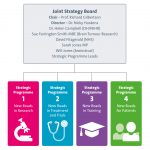Last month our Support Specialist for the Midlands, Jodie, and our Paediatric Support Specialist, Khadijha, completed their coaching training.
So, what does this means for the people they support?
As trained coaches, our Support Specialists specialise in helping you to identify how to make change happen. They will work with you to identify what you need to do to help you feel in control. This can mean helping you to identify what questions you need answered, what you value most, and who’s on your team to give support when you most need it.
Through a 5 module coaching training programme, our Support Specialists learnt about the different theories and models involved in coaching, as well as the different roles within a coaching relationship. It also gave them the ability to identify different models and tools that could be beneficial when supporting people living with a brain tumour.
Jodie, our Support Specialist for the Midlands, said of her training:
“By taking part in this training, not only has it helped with my own personal development for my role at brainstrust, but it has also helped me gain a deeper insight into the true impact that coaching can have on people dealing with difficult situations. Looking forward, I hope that I will be able to use what I have learnt to further support our community.”
What is coaching?

Coaching aims to allow our community to improve their wellbeing by working on the here and now rather than the past. We believe that patients and caregivers have the capacity to take control of their situation to secure the best possible outcomes for their situation. We know too that by empowering our community through coaching it has autonomy, a better quality of life and more patient satisfaction.
Our high impact coaching sets us apart. When we are no longer to able to change a situation, we are challenged to change ourselves. You are the person who is ultimately going to have the greatest impact on your life. Our coaching relationship enables people who are living with a brain tumour to face their challenges, so that they learn how to develop resilience and utilise our resources, and those of others, to their full potential.
What is the difference between coaching and counselling?
A coach is a someone that helps you understand where you are at today and then support you by using tools and strategies to move forward and closer to your goal. A coach will not tell you what to do but instead be a listening ear and let you discover what you want to do.
Counselling is with a specialist who creates a safe haven for you to speak and explore who you are and what you want to achieve in life. They support you to identify and solve problems.
So, the main difference is that coaching works on the present and future whereas counselling can be fixing problems for the present and deal with the past. Counselling comes into play in brainstrust when there is too much distress and a psychological intervention is needed. Something is wrong and needs fixing. It is suitable for someone who is struggling to cope or feeling very anxious or depressed. On the other hand, if you’re looking for focused help in reaching specific goals in the present, then a coach would be a great choice.
Need help now?
At brainstrust we offer both counselling and coaching. For counselling referrals head to our webpage here.
If you think coaching is for you, send us an email to hello@brainstrust.org.uk and we will link you up with your regional Support Specialist.





